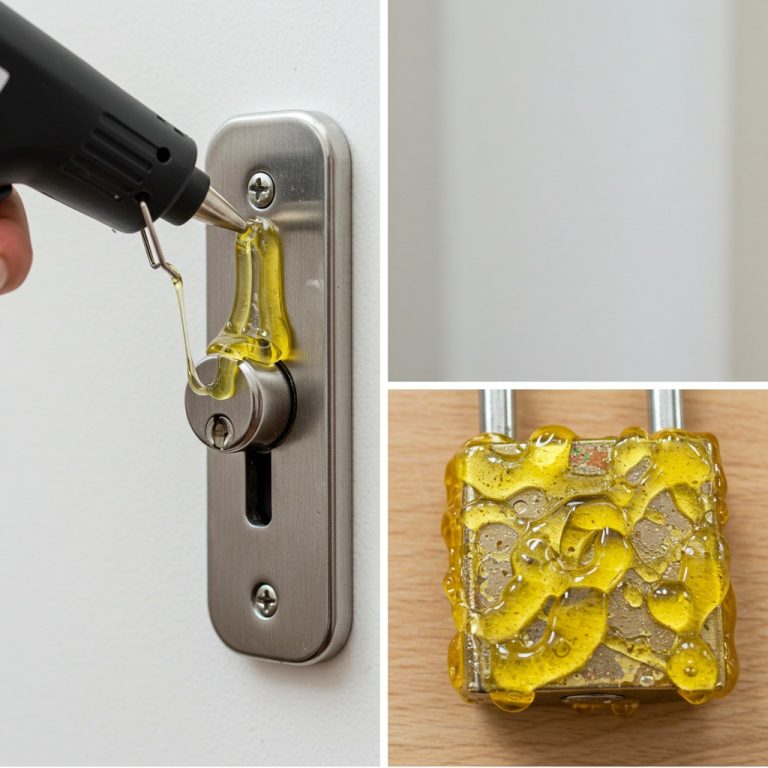ADVERTISEMENT
Sure! Here’s an article on the topic “Applying a Tube of Hot Glue to the Lock Will Save You This Inconvenience”:
🔒 Applying a Tube of Hot Glue to the Lock Will Save You This Inconvenience
Locks are essential for keeping our homes, cars, and valuables secure. However, there are times when locks can become a source of frustration rather than protection. A common issue many people face is when a lock becomes jammed, sticky, or hard to turn due to dirt, moisture, or general wear and tear. While you could call a locksmith or invest in a professional repair, there’s a quick and surprisingly effective DIY solution: using hot glue!
Yes, you read that right — applying a tube of hot glue to the lock can solve many common inconveniences that arise with a sticky, malfunctioning, or hard-to-turn lock. Let’s explore how this simple trick works and why it might just save you from a frustrating experience.
🛠️ Why Do Locks Get Stuck or Hard to Turn?
Before diving into how hot glue helps, it’s important to understand why locks can stop working smoothly. Some of the most common causes of a sticky or jammed lock include:
1. Dirt and Debris Build-Up
Locks can easily accumulate dirt, dust, and grime, which can get trapped inside the keyhole or the mechanism. Over time, this buildup can cause the lock to become stiff and hard to turn, leading to frustration when trying to open or close the lock.
2. Moisture and Rust
Exposure to moisture, such as rain or humidity, can lead to rusting and corrosion of the lock components. As metal parts corrode, they may become sluggish or difficult to move, which makes unlocking and locking the door a cumbersome task.
3. Worn-Out or Damaged Internal Components
Like anything with moving parts, locks can experience wear and tear. Internal parts like springs, pins, and tumblers can become worn out over time, leading to issues with the lock’s functionality.
4. Infrequent Use
A lock that is rarely used may become stiff and difficult to turn. The lack of movement can cause the parts inside the lock to seize up and eventually result in a malfunction.
🔥 How Hot Glue Can Solve the Problem
Now, let’s talk about the hot glue solution! While it may sound unconventional, applying a small amount of hot glue to the keyhole or around the lock mechanism can actually help resolve a variety of issues. Here’s how:
1. Smooths Out the Mechanism
Hot glue, when applied carefully, can create a protective barrier that prevents dirt, dust, and moisture from getting inside the lock. By sealing small gaps and cracks where debris could enter, the hot glue helps keep the lock cleaner for longer. As a result, the mechanism can work more smoothly, making the key turn more easily.
2. Reduces Rust and Corrosion
If your lock has been exposed to moisture, rust may already be affecting its functionality. A thin layer of hot glue can create a moisture-resistant seal around the lock, protecting the internal components from further rusting or corrosion. The glue prevents rain, snow, or humidity from reaching the lock’s sensitive parts.
3. Temporary Fix for a Stiff Lock
In some cases, a stiff lock might simply need a little lubrication. Hot glue can act as a temporary lubricant that helps the internal mechanisms move more freely. This is particularly helpful for locks that haven’t been used for a while and have become difficult to turn. Hot glue can provide a smoother surface for the key to turn, easing the effort required to unlock or lock the door.
💡 How to Apply Hot Glue to a Lock: A Step-by-Step Guide
If you’ve decided to give this trick a try, here’s a simple guide to apply hot glue to your lock:
For Complete Cooking STEPS Please Head On Over To Next Page Or Open button (>) and don’t forget to SHARE with your Facebook friends
Materials Needed:
- Hot glue gun
